In situ construction of interconnected ion transfer channels in anion-exchange membranes for fuel cell application†
Abstract
To resolve the trade-off between conductivity and stability in anion-exchange membranes (AEMs), we proposed a strategy to modulate the membrane morphology from isolated ionic clusters to interconnected channels by precise adjustment of the amphiphilic architectures. From the perspective of AEM molecular designing, by synchronously increasing the amphiphilic segments, well-connected conductive nano-channels, comprising overlapped larger hydrophilic domains (35–40 nm), were constructed and validated by percolation theory. The whole synthesis process was green, avoiding the toxic chloromethyl methyl ether route. The unique molecular, spatial and micro-structures enabled the membranes to exhibit excellent performance. The connective hydrophilic channels significantly enhanced the conductivity, while the increasing hydrophobicity reduced the water uptake and swelling, improving the dimensional and chemical stability of the membranes. This strategy successfully solves the trade-off issue between conductivity and stability in AEMs.



 Please wait while we load your content...
Please wait while we load your content...